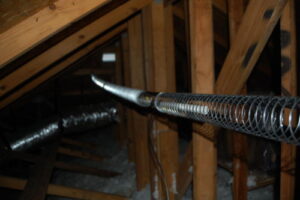How Far Does Ham Radio Work? [FREE DOWNLOAD – Tips for Passing the Ham Radio Exam]
Amateur Radio, Emergency Communication, Technician
Many people plan to use ham radios to keep in touch with family and friends when disaster, mayhem, or the collapse of society strikes, but few understand its capabilities, and more importantly its limitations. A common question is, “How far does ham radio work?” The simple answer is, “As far as you need it to.”
The better answer is, “How far ham radio waves will travel (propagate) depends on a series of variables:
- How much transmitting power is available?
- What type of antenna is used?
- What frequencies are available?
- How powerful is the transmitter?
- What mode of transmission is used?
- What time of year is it?
- What time of day it is?
- What is the solar flux index?
The list above makes it obvious that there are a lot of variables. And some of those variables are going to be dictated by what class ham radio license you have.
But we can discuss that later. First, let’s look into the possibilities before we dig into the details.
HOW FAR DOES HAM RADIO WORK?
Using a modest radio and antenna I’ve talked from my home in Florida with ham radio operators in more than 150 countries and territories as far away as Japan, New Zealand, and even Antarctica. Hearing and talking to European hams is sometimes a daily occurrence. Chatting with people on the U.S. west coast? That is a daily occurrence. Checking in with people up and down the I-95 corridor from the Florida Keys to Maine? Right now, as I’m writing this, I’m listening to dozens of hams share travel information from along the I-95 corridor and as far west as the Mississippi River.
What do I consider a modest radio station? Well, the radio I most often use for worldwide communication transmits no more than 100 watts. That’s less than the incandescent lightbulbs we used to use to light our homes. And my antenna? I’ve used everything from old speaker wire to Slinky toys to the gutters of my house. But that’s my home station. The mobile station in my “vintage” 1997 Chevy Suburban transmits 50 watts and I’ve talked with people from California and Poland while I drove around town. I’ve also used a portable 15-watt radio and a whip antenna while backpacking in Ocala National Forest to make contact with hams on every continent.
But there’s more. Under the right conditions, it’s possible to talk around the world with less than one watt. And I’ve heard the legend, though I’ve never experienced it myself, that when propagation is at its peak some people have heard the tail end of their own transmission coming around the entire globe and reaching their receiver.
And ham radio isn’t limited to earth-bound communication. Some ham radios and frequencies allow communication with the International Space Station, which isn’t difficult to do from an equipment standpoint, even a 5-watt walkie-talkie can do the job, but timing and tracking the ISS or other ham radio satellites is tricky.
Still not far enough for you? There’s also Earth-Moon-Earth propagation. It’s commonly called “moonbounce.” Yep, it’s possible to bounce a radio signal off the moon and back to earth.
So, here’s the answer to the question “How far does ham radio work?” To the moon and back.
HOW FAR DOES A HAM RADIO WALKIE-TALKIE WORK?

The entry point into the U.S. ham radio world is the Technician Class License. The Technician Class radio operator is granted access to all ham radio very-high and ultra-high frequencies (VHF and UHF respectively). VHF and UHF primarily provide line-of-sight communication. Line-of-sight essentially means that if the radio antennas can “see” each other above the horizon then the transmissions will get through. This assumes that the radio has enough power output for the radio waves to make the trip.
It’s in the power output that ham radio has the distance advantage over non-licensed radio services such as CB* and the walkie-talkies (FRS) you can buy in big box stores. Under normal conditions, non-licensed radio communication is reliable only up to one mile or so. This is because non-licensed radios are limited in power compared to ham radios. FRS radios transmit less than 2 watts; CB radios less than 5. Ham walkie-talkies usually start at 5 watts.
(*Technically CB radios aren’t in the VHF range, but they behave like VHF radios.)
How far will a 5-10 watt ham radio walkie-talkie work? At least a mile. More with an unobstructed line of sight. Also, there are radio “repeaters” available to ham radio operators of all license classes. These repeaters receive radio transmissions from lower-powered radios and re-transmit them with more power through antennas that are often more than 100 feet in the air for improved line-of-sight propagation. This results in walkie-talkie coverage measured in 10s of miles, sometimes more.
Interestingly, even upgrading from a walkie-talkie to VHF/UHF base station doesn’t markedly increase transmission range for emergency communication. Using frequencies that aren’t limited by line-of-sight is a much more effective way to break through the “10s of miles” limitation. That brings us to…
HOW FAR DOES A HAM HF RADIO WORK?
PHOTO: ENGAGING PHOTO (be sure the file name includes the MAIN KEY WORD PHRASE)
In radio jargon, “HF” stands for high-frequency and long-distance radio communicators love to play in the HF neighborhood. Ironically, high-frequency radio waves are among the lowest frequencies of those available to ham radio operators.
High-frequency radio waves aren’t limited by line-of-sight. They travel hundreds of miles above the surface of the earth to the ionosphere. The ionosphere then refracts or bends the radio waves back toward the earth to a receiving antenna hundreds or thousands of miles away. (Technically, the ionosphere can refract VHF/UHF radio waves, too, but this is a rare occurrence. VHF/UHF radio waves usually punch right through and that’s why they’re used to communicate with astronauts.)
Technician Class ham radio operators have very limited high-frequency privileges. The good news is that Techs have access to the 10-meter HF band which, all things being equal, provides the longest distance propagation. The bad news is that 10-meter band propagation is significantly dependent on the 11-year sunspot cycle. This means that 10-meter frequencies often remain “quiet” for years at a time regardless of how much power and what antenna is used.
A General Class ham radio license provides increased operating privileges on at least a portion of all ham radio high-frequency bands. General Class operators also enjoy increased HF power limitations up to 1500 watts, though as I said earlier worldwide communication is possible with much less than this full legal limit.
With 100 watts and a wire, a General ham can enjoy chatting with people across town or across the globe.
HOW MUCH DOES IT COST?

Taking the ham radio exam is administered by ham radio operators and is free, or nearly free, in many cases. Once you pass the exam the FCC charges $35 to issue your license, which must be renewed every 10 years. Many people pass the exam and earn their first license through self-study. Others prefer a book or study course ranging in price from free to $50 or so. My 6-hour Ham Cram course is available from outoorcore.com.
How much does radio gear cost? As with how far will it work, how much it costs depends on a lot of variables. Most new Tech hams spend $100 for their first walkie-talkie. A base or mobile station with an antenna will range from $100-500 dollars. Buying used gear is a great way to save money, but recruit a knowledgeable, experienced ham to help you find the best deals. (By the way, owning radio gear is not necessary to study for and pass the exam. I hadn’t even seen a real ham radio station in person when I passed my Tech exam.)
Getting into HF communication is a bit more pricey. A budget of $1000-1200 is a good starting point for an HF radio, power supply, and antenna system. Again, buying used gear can help lessen sticker shock. If you’re handy with electronics, then there are even more savings to be had. I’ve never purchased an HF radio and I own seven. How did I get them? They were castoffs that people didn’t want anymore and said, “If you can fix it, you can have it.” So, I fixed them. One I fixed with a paperclip. All it needed was a missing jumper replaced on the back panel. And I build my own antennas.

Oh, and what do I do with seven HF radios? Well, I only really use three of them on a regular basis. One is my “everyday” radio and the other is in my go-kit when I deploy for emergencies and the third is in the Suburban. The others I lend to ham friends whose radio is out of commission, or when I tutor a school ham radio club, or to loan to new hams who demonstrate a commitment to serving our community when disaster strikes. I’ll bet that you’ll find at least one generous ham radio operator in your local amateur radio emergency service who’ll help you get started. Get in touch with me and I’ll help you find a local group of hams to get involved with.
